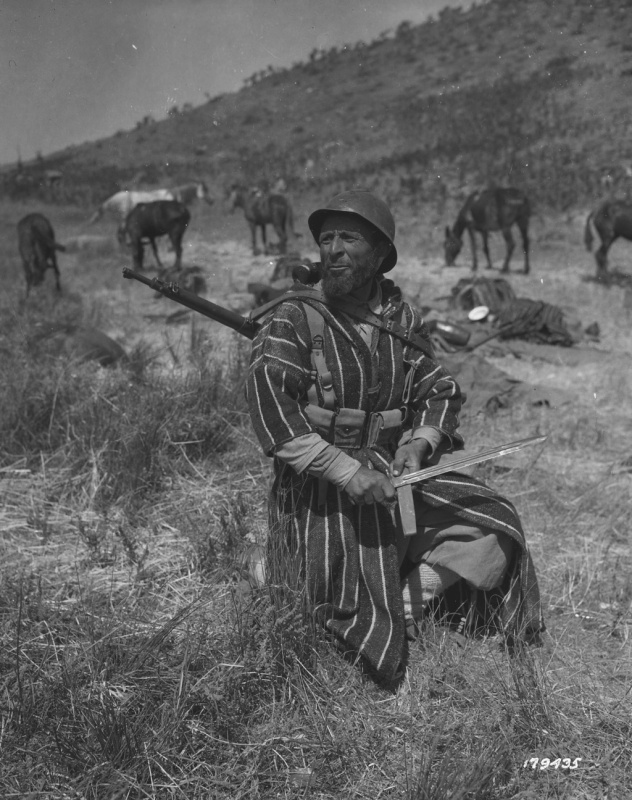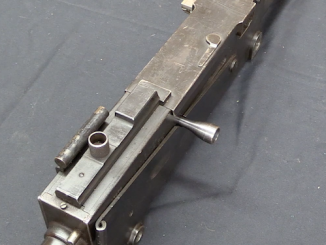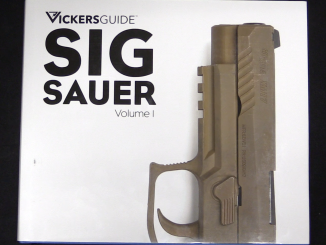While Colt put significant effort into developing a revolving rifle design, Remington chose to simply use their existing New Model revolver architecture. Remington introduced it’s Revolving Rifle (it had no other model name) in 1865, and a total of about 800 were made by 1880 when it was gone from their catalog.
The rifle was available in both .36 and .44 caliber (both holding six shots) as a percussion gun. In 1872 Remington introduced a factory rimfire cartridge conversion, in .38 Long rimfire (six shots) and .46 Long rimfire (five shots). Standard production was offered with 24, 26, and 28 inch barrels, brass furnishings, and a variety of trigger guard and sight options. The rifle was very economical for Remington to produce, as it used existing New Model revolver frames and actions, stocks from the Remington Beals single shot rifle, and really no significant changes aside from a lengthened loading lever.
In addition to the typical problems of revolving percussion rifles, the Remington was rather underpowered for a hunting rifle (as it was advertised). It was simply unable to compete with the other options, most notably Winchester’s lever action rifles.




With the standard cylinder carrying a modest powder charge, that looong barrel doesn’t seem to offer much over the (already long by handgun standards) barrel of the original.
Even though it wouldn’t be precisely historical, an 8″-barreled percussion carbine could be a classically styled, non-NFA, fun “PCC”.
Yes, you’d have to find a way to make sure it doesn’t get accidentally classified as a “short-barrel terrorist rifle” or (in stupid far left wing media terms) a “serial killer’s best friend.”
JUST KIDDING.
True, but I’ve never heard an instance where they reversed the antique exemption – other than the fact that their handbook has a picture saying that it’s illegal to make a pistol from a pre-1898 cartridge receiver (even though it clearly doesn’t meet either SBR definition).
Some of the 14″/15″ Trapper model antique Winchesters are specifically exempted from the NFA, IIRC.
Right, there are many by-name exceptions in factory condition.
I think I’d rather have Col.Mortimer’s 16”Colt SAA buntline special.
But only with the saddle mounted rifle roll.
“(…)Colt SAA buntline(…)”
This is interesting for study of legends of 19th century
https://en.wikipedia.org/wiki/Colt_Buntline
I actually own one of these in .44 percussion.I bought it in southern ontario round about 1969 at the sale where they were selling ell the wingless fairy swordfishes and Bren Gun carriers. No visible markings but not a fake it has a fancy burl walnut stock and cost me 200cnd.
I was supposed to put it up for sale at ellwood epps in orillia ontario but covid stopped that so I will have to see about it next year
Why were selling aircraft with no wings?
Why were THEY selling….
You mention the Remington catalogs from the 1800s. Since these would all be public domain, are these digitized anywhere?
If the 1890s listings I can find, Winchester rifles in .44-40 were also cheaper. Less than 11 dollars in the Ward 95 catalog (15 if you wanted a takedown).
UMC’s 1887 catalog gives .38 long rimfire at $18 per 1000, .46 rimfire as $25 per 1000, and .44 Winchester at $19 per 1000, so ammo would also be significantly cheaper than .46.
Good question Stephen. I imagine it was because they took them off to transport them to his farm and he never put them back on. Apparently he had one plane that was roped to trees and that he started for kids when they visited
Swordfish’s Pegasus engine was LOUD
What this country needs is a good 5-cent revolving rifle. Well, it’s not as if somebody isn’t always trying.
Revolving rifle is periodically reappearing idea,recently in form of MTs-569 see top half of 1st image from top https://modernfirearms.net/en/civilian-rifles/russia-civilian-rifles/mts-569-mts-570/